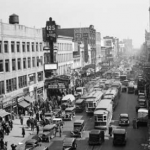 At America’s first urban planning conference, held in New York in 1898, a British planner asked whether he and his colleagues were striving for beautiful people or beautiful cities. Is urban planning about physical design, he wondered, or about making things easier for the people who live in our urban spaces?
At America’s first urban planning conference, held in New York in 1898, a British planner asked whether he and his colleagues were striving for beautiful people or beautiful cities. Is urban planning about physical design, he wondered, or about making things easier for the people who live in our urban spaces?
It was an essential question for the field, which really wasn’t born until the early 20th century.
Before then, there were three types of people thinking about how a city should look and function — architects, public health officials, and social workers. Each group approached the question of city building very differently.
The architects were focused on the city as a built environment, implementing ideas like L’Enfant’s grand vision for Washington, D.C., and the New York City grid (set out by the Commissioner’s Plan of 1811). The public health professionals, on the other hand, were consumed with infrastructure. They knew there was a connection between certain diseases and social conditions, even if they didn’t know precisely what it was. Planning how a water system would work, or where waste should go, or how to get garbage out of a city, was the most effective way to stop diseases from spreading (see, for example, John Snow, who figured out in the 1850s that a single water pump on Broad Street in London had infected hundreds of people with cholera). And lastly the social workers wanted to use the city to improve the lives of the people living there. They wanted cleaner tenements, spaces for immigrant children to play, and more light and fresh air for residents.
These thinkers were brought together by the pressure cooker that was the Industrial Revolution. “At that moment, we began to look for technological ways to expand the city,” says Elliott Sclar, a professor of urban planning at Columbia University. “All of a sudden here’s a pressure to comprehensively plan. You can’t just put a privy wherever you want.”
In 1898, the question of the hour was horse manure. City streets were just covered in the stuff, and there were no easy answers in sight. Horses, after all, were the key mode of transportation in cities at the time. At this initial meeting, fledgling planners realized that cities needed big plans to deal with growing populations.
At that conference, and in the years that followed, any one of these early urban planning strains could have taken over as the intellectual giant in the field. Though the social workers and the public health officials continued to play a role, urban planning’s intellectual history ended up grounded in architecture.
That outcome is thanks in a large part to the creation of the country’s first urban planning school, at Harvard. The University founded a school of landscape architecture in 1898. It was, effectively, a vanity project, slavishly devoted to Frederick Law Olmstead (in fact, it was started by Olmstead’s son). At the same time, It was a place to start. Soon after, they began offering classes in city planning, a first for higher education in America.
“You couldn’t separate the design of the land from the design of the city,” says Anthony Alofsin, who wrote The Struggle for Modernism, on the history of Harvard’s urban planning school. At the beginning, the school focused on architectural history, with professors working at the city planning school along with the school of architecture and the school of landscape design. “These faculty were interchangeable, it was very collaborative,” Alofsin says.
America’s first city planners were very influenced by this focus on physical space. “The first graduates were trained as designers,” Alofsin says. “These were not policy wonks – they got hired by cities to make plans.” And plan they did. It was from these early classes that the first crop of true city-affiliated planners were born.
This had a deep impact on cities. The advent of urban-conscious planners meant that cities began to create their own master plans. Harland Bartholomew, the famed city planning consultant, prepared comprehensive or master plans for dozens communities in the early 20th century, including Memphis, Newark, New Jersey, and Columbus, Ohio.
As Stuart Meck, a professor of urban planning at Rutgers explains, cities used urban planning not to build better, or cleaner, or morally uplifting cities. They used planners to divide the city, creating beautiful spaces at the expense of the poor. In an email, he writes:
“City planning, along with zoning, was a vehicle to control where African-Americans, the poor, and immigrants lived, and to keep them out of the areas where middle and upper class people resided. It is no coincidence that the initial efforts to adopt land use controls in the U.S. were aimed at enacting racial zoning—zoning that segregated cities by race. The first city to adopt racial zoning was Baltimore in 1910, and racial zoning spread to other eastern and southern cities (e.g., Atlanta, Louisville), even though the U.S. Supreme Court declared it unconstitutional in 1917, in a case titled Buchanan v. Warley.”
The question the British architect asked at the country’s first planning conference is a perennial one for urban planners. But at the moment American urban planning was born, we chose to build cities that focused on place at the expense of people.
AMANDA ERICKSON
http://www.theatlanticcities.com/jobs-and-economy/2012/08/brief-history-birth-urban-planning/2365/
Speak Your Mind
You must be logged in to post a comment.